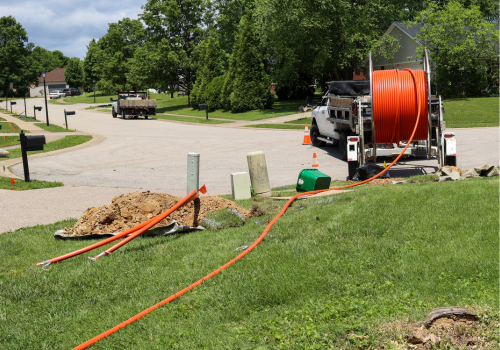Vacuum excavators, also known as vac trucks, or hydrovacs, have become an increasingly popular tool for utility companies and contractors working around underground infrastructure. Their ability to dig safely and precisely without damaging buried utilities has made them an essential part of modern excavation work. But like any piece of equipment, vacuum excavators come with both benefits and limitations.
Below, John Masley, Regional Sales Manager for Vac-Con, and Host of the VacconJohn Unplugged Podcast, and Chris Thompson, Product Manager at Ditch Witch, offer insights into the key advantages and challenges of vacuum excavation.
✅ Pros of Vacuum Excavators
1. Improved Safety Around Utilities
When digging near underground utilities, traditional mechanical digging methods pose significant risks. A single miscalculation could lead to damaged electrical lines, gas leaks, or broken water mains.
Vacuum excavators, particularly hydrovacs, reduce that risk dramatically. They use high-pressure water—up to 2,800 psi—to break up soil, then remove it using a powerful vacuum. This method, known as daylighting or potholing, doesn’t damage existing infrastructure.
To maximize safety, Thompson recommends:
- Starting with a small hole and expanding only as needed
- Keeping water pressure below 2,800 psi
- Holding the nozzle 6–8 inches above the utility
- Continuously moving the nozzle to avoid concentrated pressure
- Never using the nozzle like a shovel
2. Versatility Beyond Utilities
Though commonly used for utility work, vacuum excavators serve many other functions:
- Slot trenching for locating utility lines
- Soft digging for installing utility poles
- Drill support during horizontal directional drilling (HDD)
- Cleaning storm and sewer lines using combo trucks with hoses up to 1,000 feet long
According to Thompson, these machines are also becoming more common in landscaping. “They assist landscapers with projects like mulch removal without harming nearby flowers or turf,” he explains. “They’re also useful for tree installation and improving soil conditions for healthy root growth.”
3. Less Surface Disruption
Vacuum excavation is minimally invasive compared to backhoes or hand digging. It preserves landscaping, reduces damage to pavement, and helps avoid the need for large trench boxes or extra space for worker entry.
Masley adds, “Before hydrovacs, crews would dig with a mechanical excavator until close to the utility, then hand dig the rest. That not only took more time, but also required a wider, deeper hole to accommodate workers, which adds cost and safety concerns.”
4. Performance in Cold or Challenging Conditions
Vacuum excavators can be outfitted with a boiler to heat water between 140°F and 170°F. This makes it easier to excavate frozen ground or clay-rich soils.
“Clay and other dense materials can become tacky during suction,” says Masley. “Hot water makes these materials more viscous and easier to vacuum out.”
Dealers also provide valuable insights for specific soil conditions and can help contractors select the right machine for their region.
For more information on maximizing vac truck performance in cold weather, check out our article: Maximizing Vac Truck Efficiency in Cold Weather
❌ Cons of Vacuum Excavators
1. Higher Initial Cost
Vacuum excavators—especially larger models with greater capacity—require significant upfront investment. For new or small contractors, this can be a barrier.
“One common mistake is selecting the wrong size for the job,” says Thompson. “While a smaller machine may seem more affordable, it might not meet long-term needs, especially for contractors who want to bring excavation in-house instead of subcontracting.”
2. Waste Disposal Challenges
Vacuumed material (slurry) is often considered contaminated and must be taken to an approved waste facility. This adds time and operational costs, especially for smaller units with limited tank capacity.
“A smaller debris tank may save you money initially,” says Masley, “but if you’re making multiple trips to dump waste, you lose time and burn more fuel.”
3. Training and Learning Curve
Operating a vacuum excavator safely and effectively requires training. Improper use of the nozzle, incorrect water pressure, or poor maintenance habits can lead to downtime or even safety hazards. Contractors must invest time in proper operator training and certifications, especially when working in utility-dense urban areas.
4. Performance Limits in Rocky or Hard Soil
While hot water and specialized nozzles help, vacuum excavators aren’t ideal for all ground types. Rocky soils or heavily compacted areas may still require traditional excavation methods, or at least a combination approach.
Choosing the Right Size
Vacuum excavators come in debris tank sizes ranging from 3 to 16 cubic yards. Choosing the right size depends on your workflow, disposal logistics, and whether the machine will be used occasionally or as a primary excavation tool.
“Small units work well for occasional jobs or urban environments,” says Thompson. “But for high-volume or frequent use, a larger tank can reduce trips and save on long-term operational costs.”
For more information on questions to ask when buying a vac truck, check out our article: 8 Questions to Ask When Buying a Vacuum Excavation Truck
Conclusion
Vacuum excavators offer unmatched safety, precision, and versatility for a wide range of utility and excavation tasks. From reducing labor costs to minimizing surface disruption, their benefits are significant. However, they do come with higher upfront costs, disposal considerations, and a need for proper operator training.
Contractors who weigh these pros and cons carefully—and choose the right machine for their needs—can take full advantage of what vacuum excavation technology has to offer.
See Vacuum Excavation Trucks in Action at The Utility Expo 2025
Contractors and utility professionals interested in seeing the latest vacuum excavation technology in action can visit The Utility Expo 2025, October 7-9, 2025 in Louisville, Kentucky, where top brands like Ditch Witch, Vac-Con, Vermeer, and others will be conducting live demonstrations of their equipment. It’s a unique opportunity to compare models side-by-side, ask questions directly to product experts, and get hands-on with the latest advancements in vac truck design and performance.
See the full list of companies that will be exhibiting at The Utility Expo 2025, check out our full Exhibitor Directory.
Subscribe to The Utility Expo monthly newsletter to receive more industry insights like this.
Read Next
8 Questions to Ask When Buying a Vacuum Excavation Truck
Are Hydrovacs the Future of Excavation?
Maximizing Vac Truck Efficiency in Cold Weather
The Latest Advancements in Horizontal Directional Drilling (HDD) Equipment












